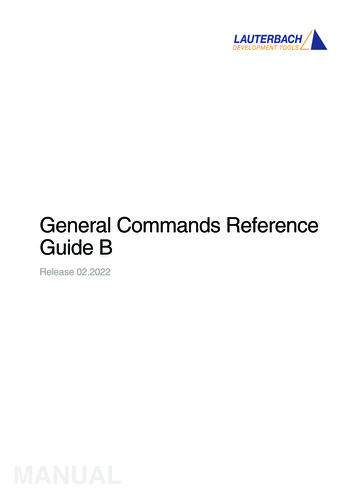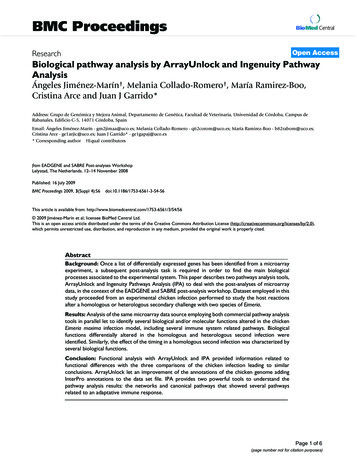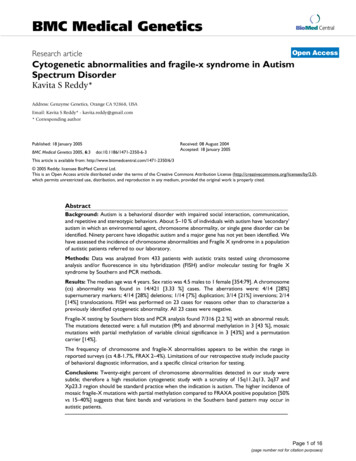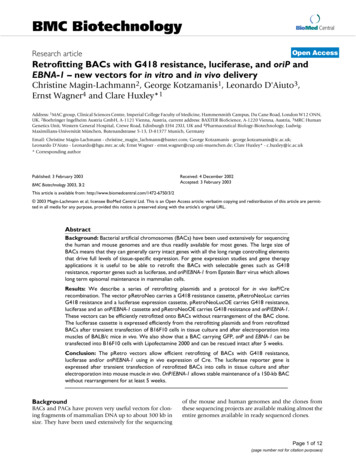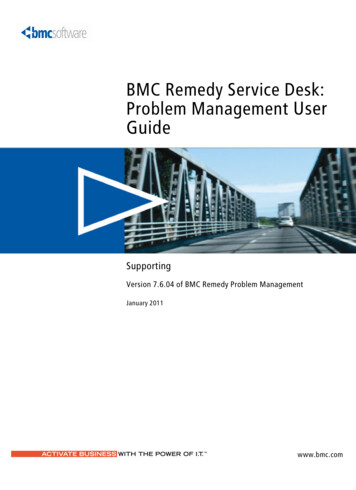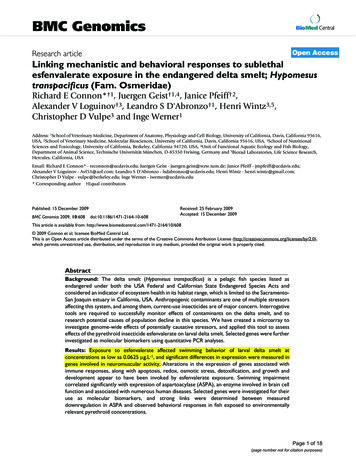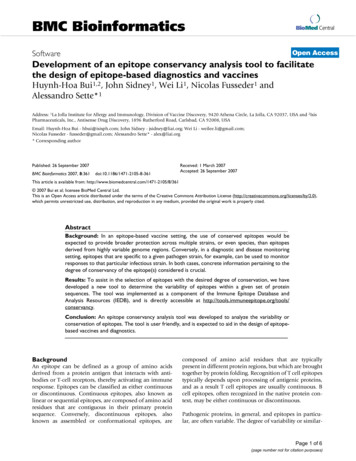
Transcription
BMC BioinformaticsBioMed CentralOpen AccessSoftwareDevelopment of an epitope conservancy analysis tool to facilitatethe design of epitope-based diagnostics and vaccinesHuynh-Hoa Bui1,2, John Sidney1, Wei Li1, Nicolas Fusseder1 andAlessandro Sette*1Address: 1La Jolla Institute for Allergy and Immunology, Division of Vaccine Discovery, 9420 Athena Circle, La Jolla, CA 92037, USA and 2IsisPharmaceuticals, Inc., Antisense Drug Discovery, 1896 Rutherford Road, Carlsbad, CA 92008, USAEmail: Huynh-Hoa Bui - hbui@isisph.com; John Sidney - jsidney@liai.org; Wei Li - weilee.li@gmail.com;Nicolas Fusseder - fusseder@gmail.com; Alessandro Sette* - alex@liai.org* Corresponding authorPublished: 26 September 2007BMC Bioinformatics 2007, 8:361doi:10.1186/1471-2105-8-361Received: 1 March 2007Accepted: 26 September 2007This article is available from: http://www.biomedcentral.com/1471-2105/8/361 2007 Bui et al; licensee BioMed Central Ltd.This is an Open Access article distributed under the terms of the Creative Commons Attribution License (http://creativecommons.org/licenses/by/2.0),which permits unrestricted use, distribution, and reproduction in any medium, provided the original work is properly cited.AbstractBackground: In an epitope-based vaccine setting, the use of conserved epitopes would beexpected to provide broader protection across multiple strains, or even species, than epitopesderived from highly variable genome regions. Conversely, in a diagnostic and disease monitoringsetting, epitopes that are specific to a given pathogen strain, for example, can be used to monitorresponses to that particular infectious strain. In both cases, concrete information pertaining to thedegree of conservancy of the epitope(s) considered is crucial.Results: To assist in the selection of epitopes with the desired degree of conservation, we havedeveloped a new tool to determine the variability of epitopes within a given set of proteinsequences. The tool was implemented as a component of the Immune Epitope Database andAnalysis Resources (IEDB), and is directly accessible at onclusion: An epitope conservancy analysis tool was developed to analyze the variability orconservation of epitopes. The tool is user friendly, and is expected to aid in the design of epitopebased vaccines and diagnostics.BackgroundAn epitope can be defined as a group of amino acidsderived from a protein antigen that interacts with antibodies or T-cell receptors, thereby activating an immuneresponse. Epitopes can be classified as either continuousor discontinuous. Continuous epitopes, also known aslinear or sequential epitopes, are composed of amino acidresidues that are contiguous in their primary proteinsequence. Conversely, discontinuous epitopes, alsoknown as assembled or conformational epitopes, arecomposed of amino acid residues that are typicallypresent in different protein regions, but which are broughttogether by protein folding. Recognition of T cell epitopestypically depends upon processing of antigenic proteins,and as a result T cell epitopes are usually continuous. Bcell epitopes, often recognized in the native protein context, may be either continuous or discontinuous.Pathogenic proteins, in general, and epitopes in particular, are often variable. The degree of variability or similar-Page 1 of 6(page number not for citation purposes)
BMC Bioinformatics 2007, 8:361ity of specific proteins or protein regions can provideimportant information regarding evolutionary, structural,functional, and immunological correlates. Given a set ofhomologous proteins, phylogenetic relationships can beconstructed and used to calculate the evolutionary rate ateach amino acid site. Regions that evolve slowly are considered "conserved" while those that evolve rapidly areconsidered "variable". This approach is widely used insequence conservation identification and mapping programs such as ConSeq [1] and ConSurf [2,3]. However, tofully describe and characterize protein and/or epitope variability, measures of identity and conservancy are typicallyutilized. Identity refers to the extent to which two aminoacid sequences are invariant, and is measured as the percentage of identical amino acids in the alignment of twosequences. Conservancy is defined as the fraction of protein sequences that contain the epitope considered at orabove a specified level of identity. Conversely, the fractionof protein sequences that contain the epitope consideredbelow a specified level of identity reflects the degree ofvariability or uniqueness of the epitope.Amino acid residues that are crucial for retention of protein function are believed to be associated with intrinsically lower variability, even under immune pressure. Assuch, these regions often represent good targets for thedevelopment of epitope-based vaccines, as the epitopestargeted can be expected to be present irrespective of disease stage, or particular strain of the pathogen. Furthermore, these same residues are often highly conservedacross different related species, such as, for example, hasbeen found in several instances in the context of the poxviridae [4]. As a result, a vaccine containing such conserved epitopes might be effective in providing broadspectrum protection. Conversely, in a diagnostic and disease monitoring setting, epitopes that are specific to agiven pathogen can be used to monitor responses to thatparticular infectious strain, removing the confoundinginfluence of immune responses derived from previousexposures to partially cross-reactive strains or organisms.Herein, to assist in the selection of epitopes having adesired level of conservation or, conversely, variability, wehave developed an epitope conservancy analysis tool. Thetool has been specifically designed to determine thedegree of conservation or variability associated with a specific epitope within a given set of protein sequences.Despite our emphasis on epitope identification contexts,it is also apparent that the tool can be utilized for otherpurposes, such as tracking mutation of epitopes duringdisease progression. This tool was implemented as a component of the Immune Epitope Database and AnalysisResources (IEDB) [5-7] and was used in predicting thecross-reactivity of influenza A epitopes plementationApproachGiven an epitope sequence e and a set P of proteinsequences {p}, our approach is to find the best local alignment(s) of e on each p. The degree of conservation of ewithin P is calculated as the fraction of {p} that matchedthe aligned e above a chosen identity level. Two separateprocesses were developed for assessing the degree of conservation/variability of continuous and discontinuousepitope sequences.Continuous sequenceIf e is continuous, the process of finding the best alignment of e on p involves breaking p in to sub-sequences {s}of length equal to e and comparing e to each s. For a psequence of length n and an e sequence of length m, atotal n-m 1 {s} different sequences are generated. Foreach e and s comparison, the degree of identity is calculated as a percent of residues that are identical between thetwo sequences. If p contains repeat regions, or the identitythreshold is low, multiple alignments may be found for e.However, the s sequence(s) associated with the maximumidentity score determines the alignment(s) of e on p. Thedegree of conservation of e is then calculated as the percent of p sequences in which e is aligned with an identitylevel at or above a chosen threshold. Conversely, thedegree of variability is calculated as the fraction of p that ewas aligned below a chosen threshold. An illustrative conservancy analysis of a continuous epitope sequence isshown in Table 1.Discontinuous sequenceIf e is discontinuous, a continuous sequence pattern c isfirst generated. For example, given a discontinuoussequence "A1, B3, C6" (meaning A is at position 1, B is atposition 3 and C is at position 6), its matching sequencepattern c is AXBXXC where X is any amino acid residue,and the number of X's between two nearest known aminoacid residues is equal to the gap distance between them.Next, the same procedure described for continuoussequences is used to identify the best alignment(s) of c onp. The identity level is calculated based on the definedepitope residues. An illustration of a discontinuoussequence conservancy analysis is shown in Table 2. Toobtain meaningful results, the program only performs calculations for discontinuous sequences consisting of atleast three identified residues.Program descriptionThe epitope conservancy analysis tool was implementedas a Java web-application. An overview of the tool isshown in Figure 1. As input, the program requires the userto provide an epitope set, consisting of one or moreepitope sequences, and a set of protein sequences againstwhich each epitope is compared to determine conserv-Page 2 of 6(page number not for citation purposes)
BMC Bioinformatics 2007, able 1: Example conservancy analysis of a continuous sequenceReference sequence1Identity2SourceFLPSDFFPSVNo.(%)Strain 1Strain 2Strain 3Strain 4Strain 5Strain 6Strain 7Strain 8Strain 9Strain 90)(100)64(60)(40)Total: conservancy at identity threshold 80%Total: variability at identity threshold 80%1. Residues that are different from that of the corresponding residue in the reference sequence are highlighted in bold.2. Identity indicates the number (%) of residues in the homologous sequence that are identical to the corresponding residue in the referencesequence.3. Totals indicate the number (%) of strains in which the reference sequence is found with an identity above or below the indicated threshold.ancy. Based on our experience, to achieve the best resultsit is recommended that the protein sequence set utilizedbe constructed such that redundancies are eliminated andthe representation of different substrains and serotypes isbalanced. To assist in assembling protein sequence sets, a"Browse for sequences in NCBI" link is provided. Whenthis link is selected, a browser is opened, enabling the userto search for all available protein sequences in NCBI,grouped by organism taxonomic level. To reduce redundancies in the protein sequence set, the user can check thebox at the bottom of the input form to have the programautomatically remove all duplicated sequences in the protein data set used in the analysis. As output, the programwill calculate the fraction of protein sequences that matcheach epitope sequence above or below a given identitylevel. The program also calculates the minimum and maximum matching identity level for each epitope. A positionmapping of epitope sequences to matching protein subfragments is also provided and can be viewed by clickingon the "Go" link in the "View details" column. DetailedTable 2: Example conservancy analysis of a discontinuous sequenceReference sequence1Identity2SourceFXXXDFFXXVNo.(%)Strain 1Strain 2Strain 3Strain 4Strain 5Strain 6Strain 7Strain 8Strain 9Strain )(100)73(70)(30)Total: conservancy at identity threshold 80%Total: variability at identity threshold 80%1. Residues that are not defined in the reference sequence are highlighted in italics. Residues that are different from that of the correspondingresidue in the reference sequence are highlighted in bold.2. Identity indicates the number (%) of residues in the homologous sequence that are identical to the corresponding residue in the referencesequence. Residues highlighted with gray shading are not considered in calculating the identity because they are not defined in the referencesequence.3. Totals indicate the number (%) of strains in which the reference sequence is found with an identity above or below the indicated threshold.Page 3 of 6(page number not for citation purposes)
BMC Bioinformatics 2007, igureAnoverview1of the epitope conservancy analysis toolAn overview of the epitope conservancy analysis tool.sequence mappings of an epitope to all protein sequencesin a dataset are also generated. In some cases, if a proteinsequence has significant repeat regions, or the level ofmatching identity is set at a low value, multiple matchingprotein sub-fragments can be found for a given epitopesequence. All calculation results can be downloaded astext files by clicking on the "Download data to file" button.Results and discussionTo determine the degree of conservation of an epitopewithin a given set of protein sequences, it is necessary toalign the epitope to each protein sequence. The degree ofconservation is then calculated as the fraction of proteinsequences that match the aligned epitope sequence abovea defined identity level. Conversely, the degree of variablity is calculated as the fraction of protein sequences thatmatch the aligned epitope sequence below a defined identity level. For continuous epitopes, existing sequencesearching and alignment tools, such as BLAST [9] or Clus-talW [10], can be used to perform pair-wise local alignment of the epitope to a protein sequence. But, to berelevant in an immunological context, it is crucial that theentire epitope sequence is completely aligned with absolutely no gaps. This requirement entails the use of somewhat different parameters making it cumbersome to usecurrently existing alignment tools for the characterizationof immune epitopes. At the same time, there is no alignment tool currently available for analyzing discontinuoussequences. To rectify these shortcomings, we have developed a robust, user-friendly, epitope conservancy analysistool. The tool has the capacity to simultaneously align andassess the degree of conservation/variability of eachepitope, and can perform these functions for both linearand discontinuous peptide epitope sequences.For the purpose of developing cross-reactive vaccines thataim toward highly variable pathogens, the use of conserved epitopes across different species is desired. Nevertheless, care should be taken to avoid selecting epitopesPage 4 of 6(page number not for citation purposes)
BMC Bioinformatics 2007, hat are conserved between the pathogen and the host asthis could lead to undesirable induction of auto-immunity. Moreover, extremely conserved epitopes betweenspecies are sometimes less immunogenic because theymay be derived from proteins that resemble similar proteins in the host. As a result, they are less likely to be recognized by T cells due to self-tolerance. It should also beemphasized that conservation at the sequence level doesnot assure that the epitope will be equally recognized andcross-reactive. This is due to the differences in the antigensequences from which the epitope is derived. For T cellepitopes, whether they will be processed in the first placeis determined by flanking residues that are different fordifferent antigens. Therefore, the same epitope sequencefrom different antigens may or may not be generated tosubsequently presented and recognized by T cell receptors.strains or isolates, it might be necessary to identifyepitopes that are highly conserved in only a single or justa few isolates, and poorly conserved in others. Finally, theanalysis of potential homologies with sequencesexpressed by a pathogen's host, or an animal species to beused as an animal model, might be of particular relevance.We anticipate that its relevance might range from predicting poor responses due to self-tolerance and differentialperformance in animal species expressing differentdegrees of similarities with a given epitope, to predictingpotential safety problems and autoreactivity linked tocross-reactive self reactivity and molecular mimicry. Foreach of these broad applications, the analysis tool we havedeveloped provides the means to easily assemble the protein sets required to undertake the appropriate analyses,and generates the information necessary to make theappropriate design decisions.In the case of B cell epitopes, their recognition by an antibody is dependent on the antigen 3D structures. Asequence-wise conserved epitope may not be structurallyconserved as it can adopt different conformations in thecontext of the antigen structures. Exposed amino acids asopposed to buried amino acids are more important indetermining the immunogenic of a given segment of peptide. It is because only exposed residues, as observed inantigen:antibody co-crystals, can form contacts with thecomplementarity determining regions (CDRs) of the corresponding antibody. Those residues that are recognizedby a single antibody are often defined as a discontinuousepitope. The epitope conservancy analysis tool developedhere can be used to assess the pattern conservation of discontinuous epitopes. Nevertheless, pattern-wise conserved discontinuous epitopes may not be cross-reactivedue to the unknown influence of neighboring and interdispersed amino acids. As a result, if antigen structures areavailable, it may be better to predict cross-reactivity basedon the epitope's 3D structural conservation.ConclusionDepending on the specific needs of a user, an analysis ofepitope conservancy may need to be performed at variousphylogenetic levels. For example, to determine the potential of a given epitope to be cross-reactive amongst different isolates of a pathogen, or with differentmicroorganisms associated with different pathogenicity, itmay be necessary to determine conservancy within a givensub strain, type or clad, within a specific species, or withina genus, or other higher phylogenetic classification group.This type of analysis was utilized previously to identifyhighly conserved HBV derived epitopes [11,12], and alsoapplied to identify HCV, P. falciparum and HIV derivedepitopes [[13], [14], [15], [16], [17], [18], [19]]. Alternatively, to develop epitope-based diagnostic applicationsaimed at detecting all isolates of a given pathogen but notisolates from related strains, or aimed at detecting specific Operating system(s): Platform independentTo address the issue of conservation (or variability) ofepitopes or, more broadly speaking, peptide sequences,we have developed a tool to calculate the degree of conservancy (or inversely, the variability) of an epitopewithin a given protein sequence set. Conservancy can becalculated following user defined identity criteria, andminimal and maximal levels of conservancy are identified. Furthermore, the program provides detail information for each alignment executed. This epitopeconservancy analysis tool is publicly available and can beused to assist in the selection of epitopes with the desiredpattern of conservation for designing epitope-based diagnostics and vaccines.Availability and requirements Project name: Epitope Conservancy Analysis Project home page: http://tools.immuneepitope.org/tools/conservancy Programming language: Java Other requirements: Java 1.4 or higher, Tomcat 4.0 orhigher License: none Any restrictions to use by non-academics: noneAbbreviationsBLAST: Basic Local Alignment Search ToolCDRs: Complementarity determining regionsPage 5 of 6(page number not for citation purposes)
BMC Bioinformatics 2007, EDB: Immune Epitope Database and Analysis ResourcesMSA: Multiple sequence alignmentNCBI: National Center for Biotechnology Information12.13.Competing interestsThe author(s) declares that there are no competing interests.14.Authors' contributionsHHB developed the program. WL and NF participated inprogramming tasks. HHB, JS and AS wrote the manuscript. All authors read and approved the final version.15.AcknowledgementsThe authors would like to thank two anonymous reviewers for their constructive suggestions. This work was supported by the National Institutesof Health's contract HHSN26620040006C (Immune Epitope Database andAnalysis Program) and generous support from Gemini, Kirin pharmaceutical division. This is LIAI publication number n C, Glaser F, Rosenberg J, Paz I, Pupko T, Fariselli P, CasadioR, Ben-Tal N: ConSeq: the identification of functionally andstructurally important residues in protein sequences. Bioinformatics 2004, 20(8):1322-1324.Glaser F, Pupko T, Paz I, Bell RE, Bechor-Shental D, Martz E, Ben-TalN: ConSurf: identification of functional regions in proteins bysurface-mapping of phylogenetic information. Bioinformatics2003, 19(1):163-164.Landau M, Mayrose I, Rosenberg Y, Glaser F, Martz E, Pupko T, BenTal N: ConSurf 2005: the projection of evolutionary conservation scores of residues on protein structures. Nucleic AcidsRes 2005:W299-302.Pasquetto V, Bui HH, Giannino R, Mirza F, Sidney J, Oseroff C,Tscharke DC, Irvine K, Bennink JR, Peters B, Southwood S, Cerundolo V, Grey H, Yewdell JW, Sette A: HLA-A*0201, HLA-A*1101,and HLA-B*0702 Transgenic Mice Recognize NumerousPoxvirus Determinants from a Wide Variety of Viral GeneProducts. J Immunol 2005, 175(8):5504-5515.IEDB [http://www.immuneepitope.org]Peters B, Sidney J, Bourne P, Bui HH, Buus S, Doh G, Fleri W, Kronenberg M, Kubo R, Lund O, Nemazee D, Ponomarenko JV, Sathiamurthy M, Schoenberger S, Stewart S, Surko P, Way S, Wilson S,Sette A: The immune epitope database and analysis resource:from vision to blueprint. PLoS Biol 2005, 3(3):e91.Peters B, Sidney J, Bourne P, Bui HH, Buus S, Doh G, Fleri W, Kronenberg M, Kubo R, Lund O, Nemazee D, Ponomarenko JV, Sathiamurthy M, Schoenberger SP, Stewart S, Surko P, Way S, Wilson S,Sette A: The design and implementation of the immuneepitope database and analysis resource. Immunogenetics 2005,57(5):326-336.Bui HH, Peters B, Assarsson E, Mbawuike I, Sette A: Ab and T cellepitopes of influenza A virus, knowledge and opportunities.Proc Natl Acad Sci USA 2007, 104(1):246-251.Altschul SF, Madden TL, Schaffer AA, Zhang J, Zhang Z, Miller W, Lipman DJ: Gapped BLAST and PSI-BLAST: a new generation ofprotein database search programs. Nucleic Acids Res 1997,25(17):3389-3402.Thompson JD, Higgins DG, Gibson TJ: CLUSTAL W: improvingthe sensitivity of progressive multiple sequence alignmentthrough sequence weighting, position-specific gap penaltiesand weight matrix choice.Nucleic Acids Res 1994,22(22):4673-4680.Bertoni R, Sidney J, Fowler P, Chesnut RW, Chisari FV, Sette A:Human histocompatibility leukocyte antigen-binding supermotifs predict broadly cross-reactive cytotoxic T lym-18.19.phocyte responses in patients with acute hepatitis. J Clin Invest1997, 100(3):503-513.Cerny A, Ferrari C, Chisari FV: The class I-restricted cytotoxic Tlymphocyte response to predetermined epitopes in the hepatitis B and C viruses. Curr Top Microbiol Immunol 1994,189:169-186.Doolan DL, Hoffman SL, Southwood S, Wentworth PA, Sidney J,Chesnut RW, Keogh E, Appella E, Nutman TB, Lal AA, Gordon DM,Oloo A, Sette A: Degenerate cytotoxic T cell epitopes from P.falciparum restricted by multiple HLA-A and HLA-B supertype alleles. Immunity 1997, 7(1):97-112.Doolan DL, Southwood S, Chesnut R, Appella E, Gomez E, RichardsA, Higashimoto YI, Maewal A, Sidney J, Gramzinski RA, Mason C,Koech D, Hoffman SL, Sette A: HLA-DR-promiscuous T cellepitopes from Plasmodium falciparum pre-erythrocyticstage antigens restricted by multiple HLA class II alleles. JImmunol 2000, 165(2):1123-1137.Wilson CC, Palmer B, Southwood S, Sidney J, Higashimoto Y, AppellaE, Chesnut R, Sette A, Livingston BD: Identification and antigenicity of broadly cross-reactive and conserved human immunodeficiency virus type 1-derived helper T-lymphocyteepitopes. J Virol 2001, 75(9):4195-4207.Chang KM, Gruener NH, Southwood S, Sidney J, Pape GR, Chisari FV,Sette A: Identification of HLA-A and -B7-restricted CTLresponse to hepatitis C virus in patients with acute andchronic hepatitis C. J Immunol 1999, 162(2):1156-1164.Lamonaca V, Missale G, Urbani S, Pilli M, Boni C, Mori C, Sette A,Massari M, Southwood S, Bertoni R, Valli A, Fiaccadori F, Ferrari C:Conserved hepatitis C virus sequences are highly immunogenic for CD4( ) T cells: implications for vaccine development. Hepatology 1999, 30(4):1088-1098.Altfeld MA, Livingston B, Reshamwala N, Nguyen PT, Addo MM, SheaA, Newman M, Fikes J, Sidney J, Wentworth P, Chesnut R, EldridgeRL, Rosenberg ES, Robbins GK, Brander C, Sax PE, Boswell S, FlynnT, Buchbinder S, Goulder PJ, Walker BD, Sette A, Kalams SA: Identification of novel HLA-A2-restricted human immunodeficiency virus type 1-specific cytotoxic T-lymphocyte epitopespredicted by the HLA-A2 supertype peptide-binding motif. JVirol 2001, 75(3):1301-1311.Wentworth PA, Sette A, Celis E, Sidney J, Southwood S, Crimi C,Stitely S, Keogh E, Wong NC, Livingston B, Alazard D, Vitiello A, GreyHM, Chisari FV, Chesnut RW, Fikes J: Identification of A2restricted hepatitis C virus-specific cytotoxic T lymphocyteepitopes from conserved regions of the viral genome. IntImmunol 1996, 8(5):651-659.Publish with Bio Med Central and everyscientist can read your work free of charge"BioMed Central will be the most significant development fordisseminating the results of biomedical researc h in our lifetime."Sir Paul Nurse, Cancer Research UKYour research papers will be:available free of charge to the entire biomedical communitypeer reviewed and published immediately upon acceptancecited in PubMed and archived on PubMed Centralyours — you keep the copyrightBioMedcentralSubmit your manuscript here:http://www.biomedcentral.com/info/publishing adv.aspPage 6 of 6(page number not for citation purposes)
Development of an epitope conservancy analysis tool to facilitate the design of epitope-based diagnostics and vaccines Huynh-Hoa Bui1,2, . derived from highly variable genome regions. Conversely, in a diagnostic and disease monitoring setting, epitopes that are specific to a given pathogen strain, for example, can be used to monitor .
